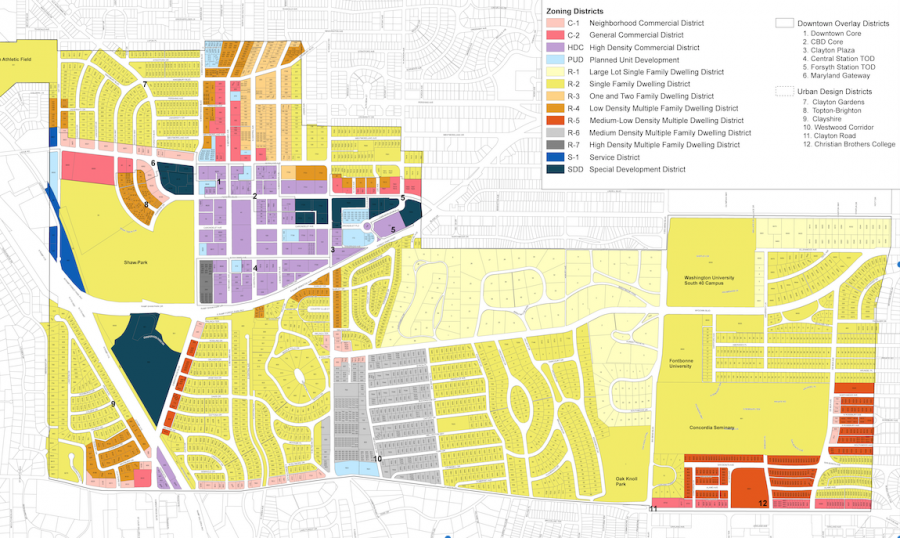I live in a duplex on the tree-lined 6400 block of San Bonita Avenue. People push strollers and walk their dogs down the shady sidewalk to buy vegan body lotion, CBD oil and artisan ice cream on DeMun Avenue. On summer evenings that buzz with cicadas, cocktails are sipped at wine bars and parents push their kids on playground swings.
Right now, this is one of the more affordable neighborhoods in Clayton. But I’ve only lived here for four years, and it already looks different.
My house is one of several rental duplexes on the block, but I’ve seen at least three of them renovated into single family homes. I looked into Saint Louis County public records and found that the house across the street was sold in 2014, the year before we moved to San Bonita. It was a duplex, and sold for $335,000. Then it was renovated into a single-family, and sold in 2017 for $676,000. The renovation more than doubled the house’s value, and now it will never lose that value.
It’ll probably get even more expensive.
The same thing happened to another house on my block. It was sold in 2016 for $345,000. The family that bought it renovated it, and now Zillow estimates its current value at $727,356.
People renovate rental duplexes and then sell them for double the original price. It’s a smart financial move. But what’s the impact on the neighborhood demographics when affordable rentals become increasingly scarce?
Middle-class families, including mine, often struggle to buy property in Clayton. That’s not to say that middle-class people aren’t incredibly privileged compared to some that can’t even dream of living in Clayton. However, the small middle class is really the most economic diversity Clayton has. I talked to realtor Laura Pierson about the challenges middle-class prospective homebuyers in Clayton encounter.
“There are pockets of Clayton that are more affordable,” Pierson says. “Mostly, in Clayton proper, they’re mostly condos. […] And so, one thing that’s hard is, if you don’t want to live in a condo, it’s really hard to buy anything here that’s under probably five or six hundred thousand. So then, some families have a hard time with condo living, if they have pets, for example. […] this is what I hear from people.”
Clayton is expensive. According to Zillow, it is home to a median property value of $680,900. In comparison, Saint Louis City’s median property value is $167,700.
Because homes are worth so much more in Clayton, the schools are exponentially better.
“Well, the truth is it’s cyclical, right, because the schools are so good, the properties are worth more. Because the properties are worth more, the taxes are higher and the schools are better,” says Pierson.
It’s all part of the cycle. According to NPR, the School District of Clayton spends $19,681 on each student, while Saint Louis Public Schools can only afford to spend $9,826 on each student. Students who live in Clayton get an education that’s worth more than double the education of kids in the city. And students who live in Clayton are usually from higher income families. The median household income in Clayton is $91,531, according to Data USA, and $41,441 in Saint Louis. So poorer students are getting a worse education.
This is the definition of socioeconomic inequality in education.
It makes sense that middle and lower-class families should be able to live in Clayton to give their kids a better education. But as long as the City of Clayton doesn’t do anything to ensure that they have places to live, the cycle will continue.
When the voluntary student transfer program ends, even for all its flaws, it will greatly impact Clayton’s already limited diversity. The rich will get richer and the poor will get poorer. Clayton will remain overwhelmingly wealthy and white, no matter how much we white liberals talk about the value of diversity. In fact, Clayton is built on a system of ensuring that wealth stays concentrated and lower-class people are kept out.
Zoning is a way cities determine how land is used. In Clayton, residential land is divided into seven residential zoning districts. These control what kind of housing can be built in different parts of Clayton. The first and most restrictive of these zoning districts is R-1, or the Large Lot Single-Family Dwelling District. This district is, according to eCode 360, “intended to maintain high standards for quality residential living.”
Zoning houses this way is Clayton protecting the upper class. There is no policy in place to protect, preserve, or create middle and lower class housing.
Most of the DeMun neighborhood is zoned as R-5, or the Medium-Low Density Multi-Family District. This district allows single family homes, duplexes and medium density multi-family homes (medium sized apartment buildings.) Because it’s zoned this way, economic diversity could flourish in DeMun, while it’s legally prevented from happening in neighborhoods with houses mainly zoned as R-1.
While that’s true, there are also no laws that prevent every duplex and apartment building in DeMun from being converted into houses that sell for $800,000 and up. Clayton is doing nothing to save the middle class, and it’s rapidly disappearing in the parts of the city where it’s zoned to exist.
But then again, why would Clayton want to save it?
Lack of socioeconomic diversity isn’t perceived as a problem by many members of the Clayton community, or at least a big enough problem that it needs immediate action.
As school board member Jason Wilson says, “Affordable housing in Clayton isn’t gonna happen. [..] there’s a paradigm that’s in place, there’s a construct that works a certain way. It was built on anti-blackness. […] I mean, it’ll be fine, honestly.”
He means that most Clayton residents won’t suffer if nothing is done to ensure diversity. It won’t affect the way of life we’ve all grown used to. As Wilson says, “nobody wants to give up anything.”
And maybe no one will.


